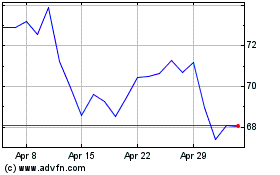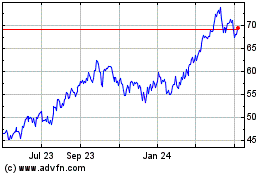UPDATE: Canada's Oil Sands Cos To Share Research On Waste Ponds
December 13 2010 - 3:56PM
Dow Jones News
Canada's major oil sands mining companies, under pressure from
regulators and environmentalists, said Monday they've agreed to
collaborate on technology to clean up the massive waste-water lakes
created by their operations.
The agreement comes as Alberta's government is requiring oil
sands miners to cut tailings production by 20% starting this year,
increasing to a 50% annual reduction by 2012. Tailings ponds--a
toxic mixture of clay, water and leftover oil--cover more than 50
square miles in northeastern Alberta and could take hundreds of
years to settle on their own.
All the current oil sands mining companies have submitted their
own plans, using different technologies, to curtail the growth of
the tailings ponds, which are projected to expand at the rapid pace
of growth in the oil sands industry. Canada is the largest exporter
of oil to the U.S. Roughly half the country's oil production comes
from the oil sands, and oil sands production is expected to double
by the end of the decade.
Under the agreement, Canadian Natural Resources Ltd. (CNQ,
CNQ.T), Imperial Oil Ltd. (IMO), Royal Dutch Shell PLC (RDSA,
RDSA.LN), Suncor Energy Inc. (SU, SU.T) Syncrude Canada Ltd.
(SYNCRUDE.YY), Total SA (TOT, FP.FR) and Teck Resources Ltd. (TCK,
TCK.A.T) will share their tailings research and technology and
"eliminate monetary and intellectual property barriers," according
to a release.
Of the tailings technologies submitted by the miners, only
Suncor's "tailings reductions operations," or TRO, technology has
met the original targets set by Alberta's government, and has been
best regarded by environmental groups. TRO uses sloping sand
beaches and a polymer additive to dry tailings over several months
into a solid surface. Suncor became the first company to remediate
an oil sands tailings pond this year.
Suncor Chief Executive Rick George has previously said he'd be
willing to share Suncor's technology with other companies for a
"nominal" fee that would offset some of the costs of Suncor's
research. Suncor has spent $250 million researching TRO and has
committed $1 billion over the next two years in implementing the
technology on its own tailings ponds.
Shelley Powell, Suncor's vice president in charge of oil sands
extraction and operations, said that under the agreement the fee
will be waived, and that Suncor will benefit from the larger
research and development capabilities of the international oil
majors like Shell, Total and Exxon Mobil (XOM), which is the
majority owner of Imperial Oil.
"We think we're going to get a real leapfrog benefit in terms of
the next round of technology," Powell said. "We can bring the
foundation of the TRO technology to the table; they can put all
their smart R&D folks together and advance it in a much quicker
way than we'd be able to do within Suncor."
Oil sands tailings ponds were the focus of intense criticism due
to the deaths of thousands of waterfowl that have landed in the
ponds and died from the toxic chemicals. Despite taking steps to
prevent such accidents, several hundred more birds died in a
Syncrude tailings pond in October.
Oil sands strip mining operations create tailings ponds, but
underground extraction methods don't. Though most current
production is mined, 80% of the oil sands are only recoverable
using underground extraction methods, and an increasing amount is
being recovered this way by companies such as Cenovus Energy Inc.
(CVE, CVE.T).
-By Edward Welsch, Dow Jones Newswires; 403-229-9095;
edward.welsch@dowjones.com
Imperial Oil (AMEX:IMO)
Historical Stock Chart
From Jun 2024 to Jul 2024

Imperial Oil (AMEX:IMO)
Historical Stock Chart
From Jul 2023 to Jul 2024
